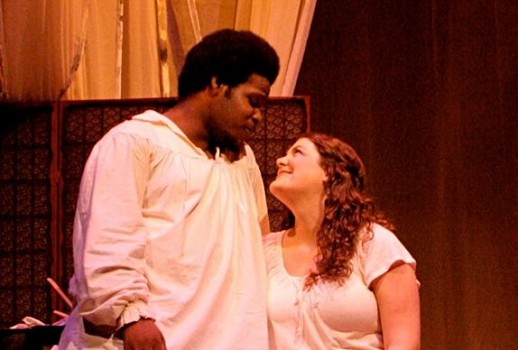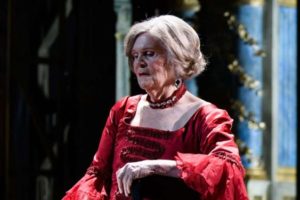

Beaumarchais, author of The Barber of Seville, fell victim to this authorial addiction. He even yielded to it himself, once (The Marriage of Figaro) with terrific success, on his own inspiration, a further time (The Guilty Mother), on the demands of others (notably his creditors), not so triumphantly. His trilogy was not written to be a trilogy, and no composer ever set all three plays to music. They prefer their own tangents, which have not abated.
I have enjoyed Mercadante’s I due Figaro and Massenet’s Cherubin, though dubious about Corigliano’s The Ghosts of Versailles. (Can Figaro Against the Zombies or The Barber of Amityville be far down the road?) Arguably, the greatest sequel to Mozart’s Figaro was Richard Strauss’s Rosenkavalier, which is full of references to the earlier composer but written in Strauss’s very personal style.
Rosina by Hiram Titus (libretto by Barbara Field), premiered in Minneapolis in 1980, has made its New York debut courtesy of dell’Arte Opera Ensemble, at the Baruch Performing Arts Center on East 25th Street. I caught the penultimate performance on Friday night.
Titus, a prolific composer in his day, best known for children’s operas like Great Expectations and The 500 Hats of Bartholemew Cubbins, was, on the evidence of Rosina, devoted to old-fashioned melody, familiar with the works of Mozart, Rossini and Strauss (repeatedly imitated and quoted), a fine writer for singers and an intriguing orchestrator. What was difficult to find here was originality, something to take home, something that said, “Titus and no other composer haec fecit” as Strauss (or Rossini) was well able to do.
The opera is through-composed, without pauses for applause, but it contains traditional “numbers,” in which the characters introduce themselves and explore their changes of feeling, plus a winsome duet or two and a very traditional concertato just before the intermission. But these pleasant melodies, even when as well sung as they were by dell’Arte, never inspired us to break in and applaud. The evening was pleasantly passed without suggesting a repeated hearing or (as Mercadante and Paisiello do) that other works in his oeuvre are worth exploring.
Field’s concocted plot for Rosina is many things. It contains comedy, wit, tension, risk, love in various styles and a tolerable denouement. What it does not offer is the psychological satisfaction that da Ponte extracted from Beaumarchais, superbly gilded by Mozart, so that we not only care about but love all the dotty characters, and rejoice at their happy conclusion.
Indeed, that happiness, that all-round forgiveness, is so great that it is difficult not be irritated with all the composers who dared imagine they could add something to it. None of them ever built higher than Mozart’s penthouse. They just tacked on a tacky satellite dish or telephone antenna. Cherubino salta sopra lo squallo!
Rosina has at least the happy alteration of centering its attention on the heroine of all three Beaumarchais plays, the Contessa Almaviva of yore. But Field and Titus’ Rosina is no match in emotional depth, pain or joy or charm, for Mozart’s ladies (or Strauss’s Marschallin). What she appears to be is Ibsen’s Nora in a Doll’s House after the break with Torvald, going off with a lover, having a child, discovering that life is not a bowl of cherries, and returning, sadder but wiser. And Harold Prince, Comden & Green and Larry Grossman have already attempted to create Nora’s musical, with disastrous results.
Picture a garret in old Madrid. Yes—Madrid, not Seville! So at once you know this is not a serious opera, Spanish rhythms or no. Zarzuelas are set in Madrid; operas are set in Seville. The garret is inhabited by Cherubino, who went to war, became bored, deserted, came home to Aguasfrescas, and eloped with the Countess, who was vexed by the Count’s resumed infidelities. Cherubino hopes to make a living as a painter, and has painted her as the Madonna 43 times (she’s the only model he can afford), but love is not feeding them or their newborn child, nor is it paying the rent.
And the landlady, a fiercely mustached customer named Pilar, threatens to toss them into the street. Their only hope is an art dealer, Mendoza, who has got offers for two of Cherubino’s madonnas. Mendoza brings the customer around—and beneath the man’s false whiskers, Rosina easily perceives her husband. And the husband has brought along a teenaged hussy named Amparo to wile away the time between numbers.
There is a ruby ring, once given by the Count to the Countess, pawned by Cherubino, purchased by the Count and presented to Amparo from whom Cherubino is obliged to extract it – offstage. (Too bad; this might have made a spicy duet.) By the time the rent is paid, the paintings are purchased, the ring is restored and three new-fledged couples have evolved, it is time for the world to end.
But we do not really understand why Rosina returns to the Count or why Cherubino does not object to losing his infant son, or what anybody sees in anybody for very long. The opera ends because it is time to end it, not to fulfill any personal journey or musical arc.
Too, Titus was running out of composers to imitate. He started well with mimic-Mozart, and then there are Spanish melodies for Cherubino and Amparo and a Rossini concertato to end the first act, though it’s not as substantial or as funny as any real Rossini concertato. This must go somewhere in Act II, and Titus goes to Strauss, embarrassingly recognizable and making one long for Ariadne. It is skillfully put together and never unkind to the ear, but one longs for any of the opera’s predecessors and their vivid originality.
All the singers in Friday’s cast were able vocally and as stage performers. They were led by Marie Masters as Rosina, the charming Mrs. Ford of last year’s Salieri Falstaff. She is charming still, especially in mid-range where Titus, wisely, keeps her, but her highest two or three notes are shrill and a beat sets in when they are pushed. Her Cherubino, Christopher Lilley, a tenor rather than a mezzo for once, has a lyrical instrument well suited to the young man’s quicksilver, changeable, flirtatious personality.
Min Gu Yeo has sung baritone roles in many operas, mostly in other languages, and his heavily accented English (besides his lack of wig) was the greatest drawback to an otherwise competent Almaviva. Elizabeth Bouk made a pretty but, on the face of it, far too sensible Amparo, a girl with a past—her heart belongs to daddy but she’d like to try someone sonny for a change.
Korland Simmons sang the all-too-obliging art dealer with the proper unction and Kerry Gotschall was Pilar, the nasty landlady not above a flirtation. Gotschall is a fine comic actress, with a deep and potentially interesting contralto, and she chewed the scenery with gusto. She might be a bit big for Rossini’s Isabella but hey, so was Stephanie Blythe; I think she’d be worth seeing in that part.
The Nagelberg Theater is small and the Metamorphosis Chamber Orchestra light (I counted eighteen but might have overlooked the harpsichord), but the singers put the text over with impressive clarity and comic acting chops—distracting titles were not present and not needed. The elementary staging was by Erin Cressy, who devised clever ways to imply the many door and window exits and entrances, the credibly crowded little set by Meganne George.
The performance was conducted by the company’s artistic director, Chris Fecteau, whose expertise at boiling down elaborate orchestrations and keeping the dramatic element paramount were so impressive in last year’s Shakespearean trilogy. This year I missed two-thirds of his Beaumarchais trilogy (which included the Paisiello Barbiere and Mozart’s Figaro), but I remain impressed by his musicality and his attention to dramatic detail. The only thing I deplore about dell’Arte Opera Ensemble is their choice of August as the month of their annual season.
Photo by Karen Rich,
























Comments